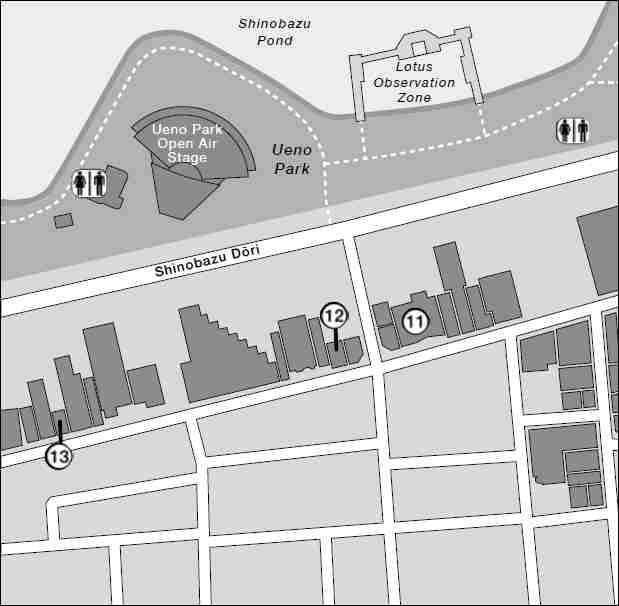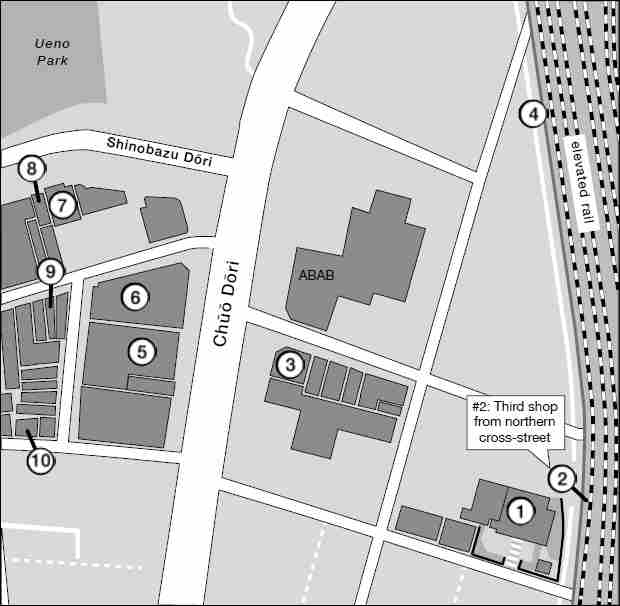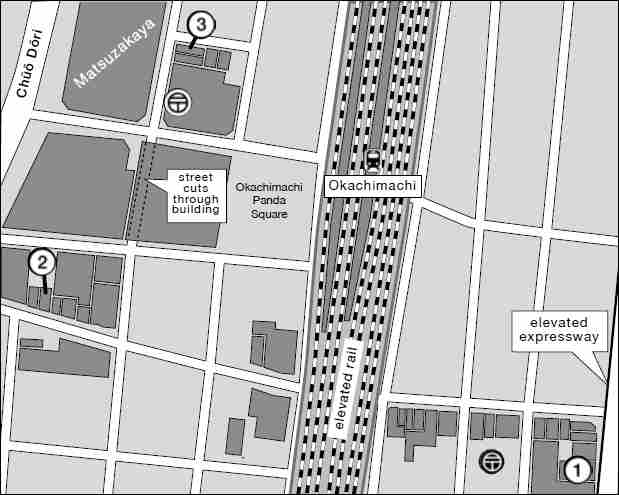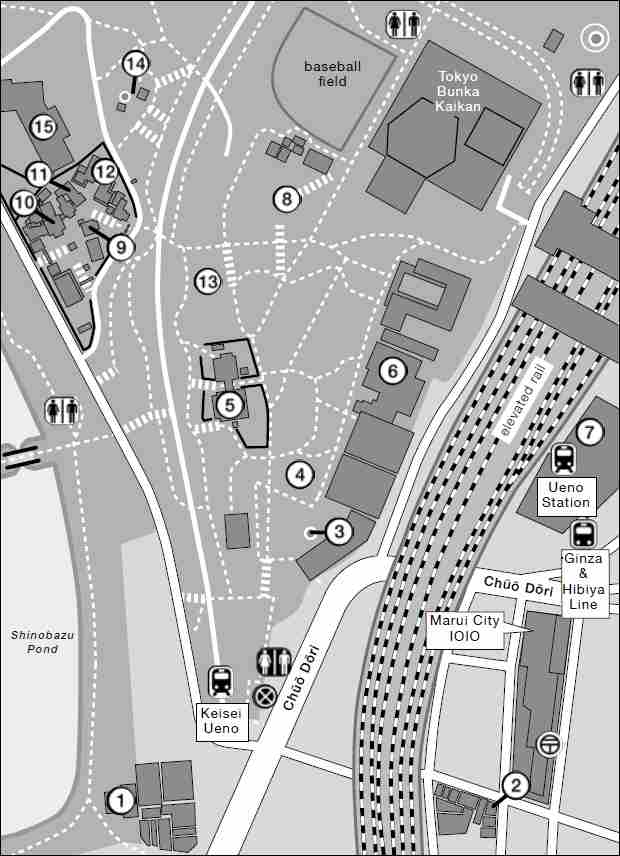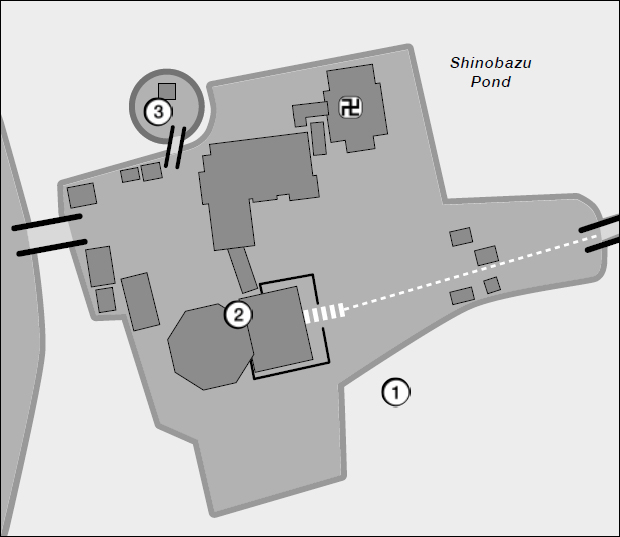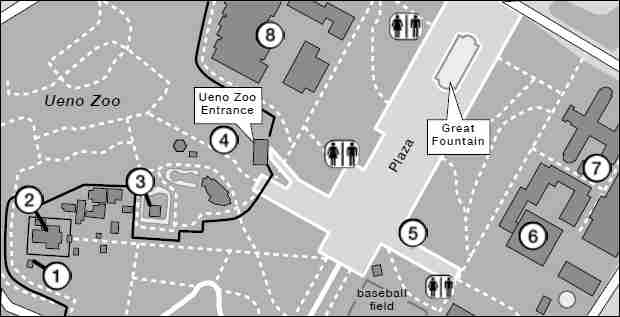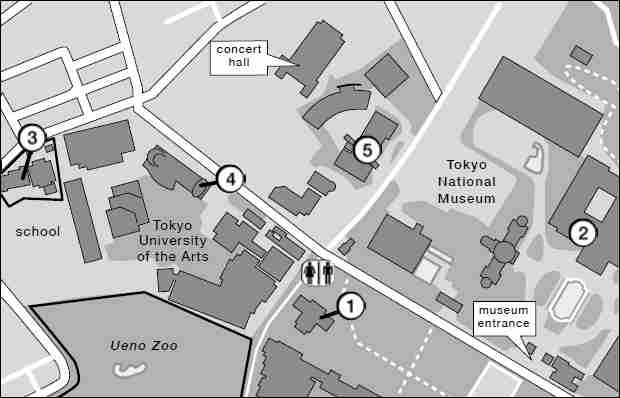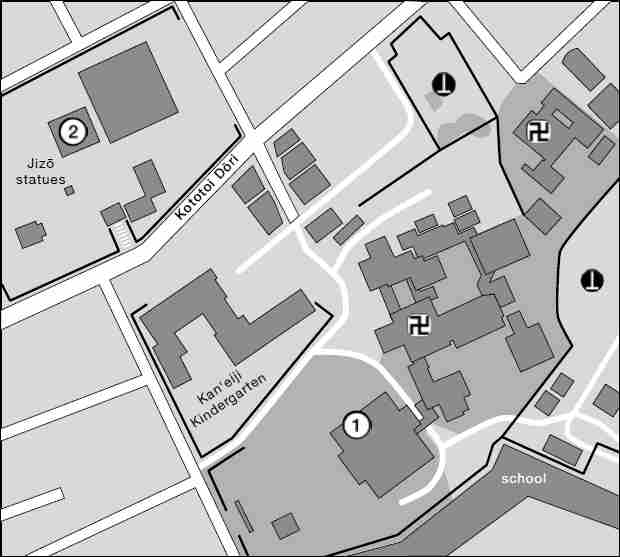上野
UENO
This area manages to pack a certain density into a small space. There is the famous park, which contains many of Japan’s major museums, the zoo, various temples, shrines, long-established shops, and interesting history from the early Edo period to the present. The park is also a relaxing place to visit. The shopping areas south of the park bustle to a degree I never anticipated before I went there. Fans of Akira Kurosawa’s films may recognize this neighborhood as the place where the gun dealer in Stray Dog lived.
Each summer from mid-July to around mid-August, the Ueno Natsu Matsuri (Summer Festival) takes place.
DETAIL 1
This Nichiren sect Buddhist temple has an interesting location above some Ameya Yokochō shops. Due to the elevated location, I walked past the temple on several trips before I knew it was there. In fact I did not find out about this temple until I was back in the US and read about it in the Kajima Institute’s book Made in Tokyo. The entrance is on a side street. If you follow the road on the west side of the tracks southward and look down the streets to your right, you will see a set of wide stairs. These lead up to Marishiten Tokudaiji. The sacred and secular are often in very close proximity in Tokyo. Marishiten is enshrined here and there is also a Jizō, which is said to help preserve your health if you wash it. People come here to pray for success in business, family safety, and health.
 http://www.marishiten-tokudaiji.com
http://www.marishiten-tokudaiji.com
UENO
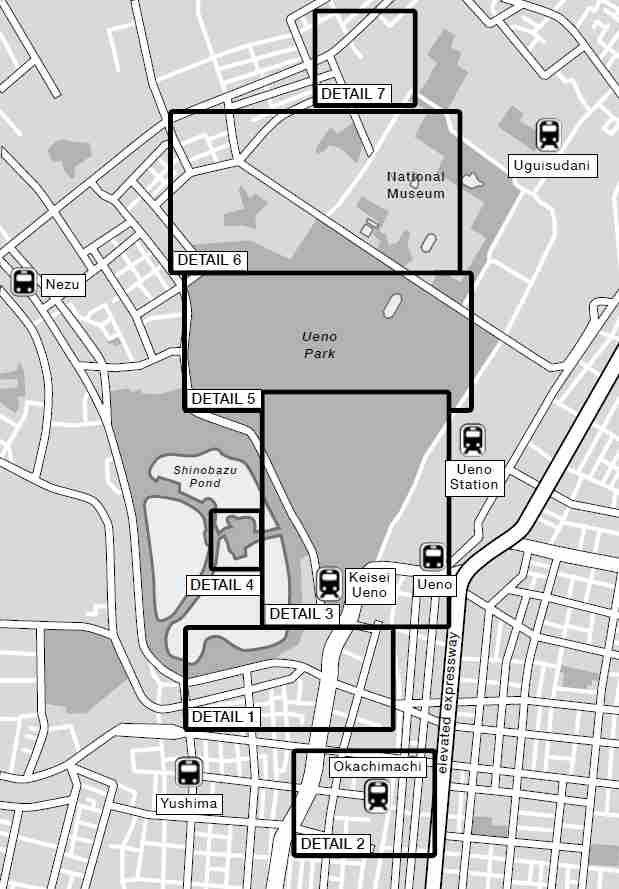
Founded in 1875, Iseoto Shōten was originally an offshoot of a wholesale shop founded in the early 1860s. This branch of Iseoto Shōten will appeal to serious cooks, and specializes in high-quality ingredients for making the Japanese stock dashi, including katsuobushi, various small dried fish, kelp, and shiitake mushrooms. Also found are some other dried food products such as wakame, scallops, shrimp, and squid. For many of their products they have several varieties so you can choose the one you prefer. They even sell katsuobushi kezuriki so you can freshly shave your own rather than rely on packages of pre-shaved katsuobushi.
Operating since 1890, this shop specializes in senbei and other small confections, such as ningyōyaki in the shape of bunraku puppet heads. Like many other places, this store burned down in the fires after the Great Kantō Earthquake. They also had to stop confectionaery sales during the war due to food shortages and were only able to reopen in 1949. The present building dates from 1988 and includes a tea room.
 Ameya Yokochō アメヤ横丁 aka Ameyoko アメ横
Ameya Yokochō アメヤ横丁 aka Ameyoko アメ横
A lively and very, very busy shopping district with hundreds of shops along and under the Yamanote Line tracks just south of Ueno Station. This area is famous for a variety of inexpensive goods sold in shops of a variety of sizes. I once bought a belt buckle in a shop the size of your average closet. The neighborhood gets very crowded on the weekends, so I highly recommend a weekday visit. This commercial area is a remnant of one of the largest Tokyo black markets of the postwar period. The black market stretched along the tracks from here all the way to Akihabara Station. Do keep your eyes out for the unusual, and be aware that some shops are in basements.
The oldest yose in Tokyo, operating since 1857. Here one can enjoy a variety of entertainments, the most well known of which is rakugo. Other performances presented here include magic tricks, paper cutting, folk songs, comedy—in short, entertainment for the masses. Shows change every ten days. Feeling hungry? Go ahead and grab a bentō and a beer, perhaps some sweets, at the kiosk in the theater before the show starts. The seats have folding tables so you can enjoy the show and your food in comfort.
 http://www.rakugo.or.jp/index.html
http://www.rakugo.or.jp/index.html
UENO DETAIL 1 WEST
Shuetsu has been selling Japanese pickles since 1675. The store is right on Chūō Dōri, with its distinctive logo of a bag tied with a cord. You can’t have Japanese cuisine without the pickles. The range they stock here is impressive: jar after jar, package after package. So many different things are pickled in Japan, and this is probably the place where you will see this more clearly than anywhere else on your trip. As their products are usually well packaged, you can pick up something to take home with you.
Originally this unagi restaurant was a roadside shack that was established sometime when Tokugawa Yoshimune was shōgun, which means between 1716 and 1745. While there are branches in other parts of Japan, this is the main restaurant, which was remodeled in 1984. I first discovered this place when my friend Ono-san asked if I would like unagi for dinner. Now, we were in Asakusa when he asked, so I assumed he meant one of the many local places. A short subway ride and walk later, we were at Izuei. The staff graciously showed us to our table, one well-dressed Japanese gentleman and three very casually dressed Americans. You will find the food delicious. If you are on a budget I recommend the eel box, which is soup, unagi over rice, and Japanese pickles. It comes in three sizes depending on how much eel is included.
UENO DETAIL 1 EAST
This shop has specialized in traditional handcrafted wooden combs since 1736. Making good combs is a task that takes great skill and requires wood that has been aged for years. There are various types of combs here, many of which are traditional designs developed when Japanese hairstyles were quite different than today’s. The combs may be plain wood or lacquered with patterns. The shop name is a pun, as jū san means “thirteen” and the numbers nine “ku” and four “shi” together can be pronounced as kushi, which means comb. The shop is small and you may actually see the crafting of a comb while you are there. A good comb well treated will last for decades, even generations.
Rengyokuan has been serving soba noodle dishes since 1859. The present location is the second one, as the restaurant moved from next to Shinobazu Pond after World War II. The building is the oldest one on the block, with an attractive wood and plaster front. This restaurant was popular with the intellectual and literary crowd in the Meiji period. Higuchi Ichiyō was one of the famous writers who ate here, and it is mentioned in Mori Ōgai’s The Wild Geese.
 http://www.norenkai.net/en/portfolio-item/rengyokuan/
http://www.norenkai.net/en/portfolio-item/rengyokuan/
This restaurant in business since 1948 bases much of its menu around variants of tonkatsu, a deep-fried cutlet usually made with pork. They also have some seafood and seasonal items. The restaurant is on the second floor of the building. Seating is Western style, servings are generous and inexpensive, and the place is 100% non-smoking.
 https://tonkatsu-musashino.tokyo
https://tonkatsu-musashino.tokyo
The oldest patent medicine shop in Tokyo, operating since 1680. They were successful in incorporating Western medicine into their formulas from early on. In the Meiji period the company was exporting to China and the United States and became a pioneer in advertising both in newspapers and with posters throughout Japan. The company even published a magazine, Hōtan Zasshi, in the Meiji period, and the narrator in Kafū’s A Strange Tale from East of the River buys some old issues at a used bookshop. The company was well enough known that their intestinal medicine Hōtan is mentioned in Natsume Sōseki’s I Am a Cat and Mori Ōgai’s Wild Geese. Hōtan is still one of their major products, so famous that the shop is sometimes called Morita Hōtan (守田宝丹).
This company founded in 1652 produces products using the kumihimo style of braiding. Kumihimo has a long history and is used in a variety of ways. It involves interlacing several colors of threads to produce items such as cords of varying thickness depending on the intended use. The process takes time, but the resulting product is one that will be recognized by anyone who has an interest in traditional Japanese crafts, as such braided cords are often used to make other items. This shop has employed the technique to make many contemporary products including bracelets, broaches, earrings, and various types of ties.
 http://domyo.co.jp/en/about/
http://domyo.co.jp/en/about/
Established in 1904, this is a humble neighborhood haunt famous for their oden and seafood. This place is perfect for night owls, especially when the weather turns chilly. You can’t go wrong with warm oden and a cold beer or sake. Just look for the tile and wood facade with the noren out to indicate that they are open.
DETAIL 2
 Mataro Dolls / Mataro Ningyō 真多呂人形
Mataro Dolls / Mataro Ningyō 真多呂人形
Established in 1919, Mataro Dolls makes exquisitely crafted kimekomi dolls for occasions such as Girl’s Day and Boy’s Day, and for general display on various themes. Some of the design themes include Heian period costumes, warriors, geisha, miniature armor sets, nō performers, and kabuki actors. They also sell tiered displays for Hina Matsuri doll sets. The company has a staff who can handle each of the stages of crafting such dolls, from the making of molds to the paint and textiles. The owner is certified by Kamigamo Shrine in Kyoto, where kimekomi doll making began.
 https://www.mataro-doll.com/en/
https://www.mataro-doll.com/en/
This restaurant has been operating since 1905 and claims to have invented tonkatsu, which is possible since that dish did originate in this area. The founder was a chef for the imperial household who specialized in Western cooking. There is both tatami and chair seating. They have an English menu, are 100% non-smoking, and accept credit cards. The restaurant is very accessible; it is barrier free and has an elevator. The menu is limited to only a few items, and the food is more expensive than most other tonkatsu restaurants in the area.
UENO DETAIL 2
Established in 1912, this was the first restaurant to use pork filets in making the popular dish tonkatsu. The famous director Ozu Yasujirō was a regular customer—the restaurant would even make deliveries to the film studio for him. Their menu is small, only four items, perhaps the ultimate of which is called Tokyo Monogatari Zen. It is named after Ozu’s famous movie known in English as Tokyo Story. The building is postwar but old-fashioned, with chair seating at a counter and traditional seating in a tatami room.
 http://www.ueno-horaiya.com/egindex.html
http://www.ueno-horaiya.com/egindex.html
DETAIL 3
 Shitamachi Museum / Shitamachi Fūzoku Shiryōkan 下町風俗資料館
Shitamachi Museum / Shitamachi Fūzoku Shiryōkan 下町風俗資料館
This museum opened in 1980 and is devoted to the commoner’s “low city” as it was found in the Taitō Ward of the 19th- to mid-20th-century. The first floor has life-sized reproductions of the tenement houses, small shops, and businesses common in that period. This museum was the first in Japan to have such reproductions. You can even take your shoes off and enter several of them. The second floor contains photo displays and artifacts from daily life. One display of special note is a table of traditional toys that you can play with. Many of these toys I played with as a child growing up in California, as they were readily available in corner stores at that time. The exhibits and toys are changed seasonally. The gift shop sells books, some in English, published by the museum.
 http://www.taitocity.net/zaidan/shitamachi/
http://www.taitocity.net/zaidan/shitamachi/
A simple, long-respected soba restaurant in operation since 1892. This is a good choice for refueling with soba or tempura. The building has a traditional brick facade with a large lantern suspended at the corner.
 Saigō Takamori Bronze Statue / Saigō Takamori Dōzō 西郷隆盛銅像
Saigō Takamori Bronze Statue / Saigō Takamori Dōzō 西郷隆盛銅像
Saigō was the commander of the Imperial Army when it marched on and took control of the city of Edo in 1868, causing the former shōgun Tokugawa Yoshinobu agreed to leave. He was also in charge of the troops during the Battle of Ueno. After serving for some time in the new government, he resigned in protest over policies and returned to his native Satsuma. In 1877 he found himself at the head of a rebellion: the leader of some 40,000 young men dissatisfied with the current regime. After nine months he was wounded in battle and chose to commit seppuku rather than be captured. Even so, he was still a hero to many for his struggles against the shōgun, and in 1898 the government had this statue by Takamura Kōun placed in the park. After the Great Kantō Earthquake the statue was covered in messages from those attempting to contact loved ones they had been separated from.
 Tomb of Shōgitai Warriors / Shōgitai no Haka 彰義隊の墓
Tomb of Shōgitai Warriors / Shōgitai no Haka 彰義隊の墓
While Edo was surrendered peacefully to the Imperial Army in 1868, not everything went smoothly. The Shōgitai, a group of about 2,000 samurai loyal to the Tokugawa, acted as a volunteer police force during the transition of power. In March 1868 Kaneiji became the headquarters for the Shōgitai. They came into conflict with the Imperial Army, which resulted in the Battle of Ueno. The bodies of the dead were left to rot in the ruins of the temple grounds. The priests gathered up the corpses and cremated them, sending most of the ashes to a temple north of Ueno. The rest of the ashes were buried where the bodies were burned. One of the surviving members of the Shōgitai, with support of other survivors, petitioned to be allowed to place a memorial marker on the site. This request was granted six years later. His family tended the plot until 2003 when the Tokyo government took over the task.
UENO DETAIL 3
This is a Tendai Buddhist temple built in 1631 under the supervision of the priest Tenkai. Originally built on Suribachiyama, it was moved to the present location in 1694. The building survived the Battle of Ueno, the Great Kantō Earthquake, and the firebombings of World War II, making it one of the oldest temple buildings in Tokyo. A multiyear restoration of the building was completed in 1996. Kiyomizu houses a Senju Kannon statue donated by the famous Otowasan Kiyomizudera of Kyoto. The statue is a hidden image and is only shown to the public on the first horse day of February. This temple mirrors the Kyoto Kiyomizudera in several ways, particularly its stage over the steep slope overlooking Shinobazu Pond. There is also an image of the Kosodate Kannon to the side of the altar, which people pray to for children. If the prayers are successful, they then offer dolls in thanks. This temple is part of the 33 Kannon Pilgrimage of Tokyo. Each September 25 the Ningyō Kuyō, a memorial service in which the offered dolls are burned, is held. On the seventeenth of each month there is a recitation of the Kannon Sutra at 10:00 a.m.
While the entrance is on the south side, you can approach from the west and southeast.
 http://kiyomizu.kaneiji.jp/english
http://kiyomizu.kaneiji.jp/english
 Ueno Royal Museum / Ueno no Mori Bijutsukan 上野の森美術館
Ueno Royal Museum / Ueno no Mori Bijutsukan 上野の森美術館
This is a private museum that has been run by the Japan Art Association since 1972. There are no permanent exhibits—instead the museum hosts a variety of shows each year. For this reason, there are often times when the museum is closed between exhibits.
Ueno Station was the terminus for trains to and from the north until the tracks were extended southward. Today it is still a major station on the Yamanote Line as well as the JR Akita Shinkansen, Hokkaido Shinkansen, Hokuriku Shinkansen, Joban Line, Jōetsu Shinkansen, Keihin-Tōhoku Line, Takasaki Line, Tōhoku Shinkansen, Utsunomiya Line (Tōhoku Main Line), and the Yamagata Shinkansen.
After the destruction of World War II, there were an estimated 5,000 refugees sleeping in the station at night. This situation continued for some time and probably helped shape local attitudes to the homeless. These days you don’t see many homeless thanks to aggressive government programs to get them into housing. When you do see them, you may be surprised how tolerant the Japanese are, even often allowing them to set up shelters in parks, something that is rarely seen these days.
An ancient Yayoi period burial mound now covered with trees. The name is used for several such mounds in the Tokyo area and means “Mortar Mountain.” This one is believed to date from the 5th century and was one of the earlier locations for Gojō Tenshinsha. It was also the first location for Kiyomizu Kannondō from 1631 to 1694. That was not the end of possible religious uses of the site, as in the Meiji period there was a movement to build a Christian church on the site that did not come to fruition. The top of the mound has benches and is a nice place to take a break.
Located next to Hanazono Inari Jinja, this small Inari shrine is easy to overlook. Ana 穴 in this case means a hole or opening. From the base of the stairs to Hanazono Inari, marked by the red torii gate, simply turn and walk in the opposite direction to find this small shrine. Keep an eye out for a gate to a narrow, dark passage to your left, and enter if the gate is unlocked. At the end you will turn left to find a delightful shrine built into the hillside. I first found this shrine out of sheer chance and curiosity.
The present building dates from 1928. This shrine was originally on Ueno hill before the temple complex was built. It was relocated to the nearby Hirokōji neighborhood, then shifted to another location in that neighborhood to make way for the railroad line, and finally moved here. As kami of medicine and learning are enshrined here, Gojō Tenjinsha is associated with medicine and academic success. One can buy charms for health or good exam results. On the tenth of every month special rites are performed. The shrine festival is held every May 25.
If you are on the major pathway of the park, with its grand cherry trees, you can identify this shrine by a row of red torii along a set of stairs going down toward the west. Warning: Tall folks may have to duck. When you reach the bottom of the stairs, Hanazono Inari is immediately to your right. This shrine is popular with those praying for matchmaking and fertility. Go ahead and check the ema for prayers in English—you may even spot some with artwork. The date of founding is not known; the present building dates from 1928.
Inshōtei is kaiseki ryōri (traditional multicourse meal) restaurant, in operation since 1875. A meal here could easily cost $100 per person, cash only. Even if you are on a budget and don’t plan to drop that much on dinner, you can still enjoy the attractive exterior of this restaurant, with its large cherry tree out front and slip bamboo fencing. The building dates from the establishment of Ueno Park, when the government encouraged the creation of a restaurant in this location as part of the facilities. Seating is both traditional and Western style.
The area that is now Ueno Park was once the site of three daimyō residences. The priest Tenkai, who advised the first three Tokugawa shōguns, wanted to build temples in the area. In 1622 the land was turned over to him and he established the shrines and temples, which still exist in the park today. Tenkai also had the famous cherry trees planted that make this a popular flower viewing destination. In the fall the ginkgo and maple leaves change color. The Battle of Ueno between samurai loyal to the Tokugawa family and imperial forces took place here on July 4, 1868. Many of the temples were destroyed in this battle, which involved artillery pieces set up on the other side of Shinobazu pond. After the Meiji Restoration, the 300 acres of temple land were confiscated by the government and in 1873 became a park, which in 1924 was given to the city in celebration of the marriage of Crown Prince Hirohito. Ueno Park today has the highest concentration of major museums in Japan. Another less famous battle was fought between the police and danshō (cross-dressing male prostitutes) on November 22, 1948. This one was well documented by reporters, since it started during a press tour given by the superintendent of police to show off the success they were having in cleaning up the park. While today there are gay bars in the area, the days of the danshō are long gone. However you may see various street entertainers as you wander through the park, especially in the area near the kōban.
While Nara and Kamakura have famous giant seated Buddha statues, Edo/Tokyo also had its own daibutsu in Ueno Park. During the Great Kantō Earthquake the head of the statue fell off, and during World War II almost all of the statue was confiscated by the military and melted down for munitions. All that now remains is the face, which was mounted on a small hill in 1972 along with a small pagoda.
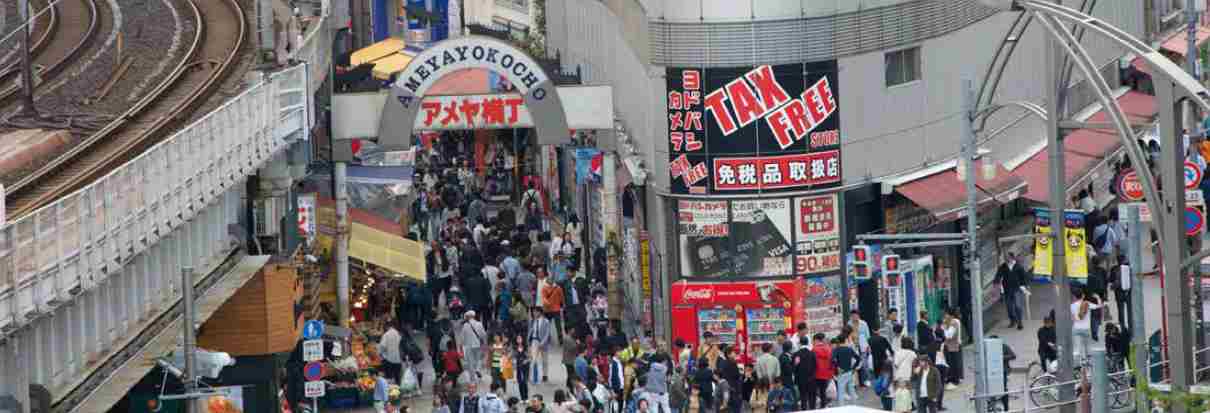
▲ Formerly a black market, Ameya Yokochō draws crowds seven days a week.
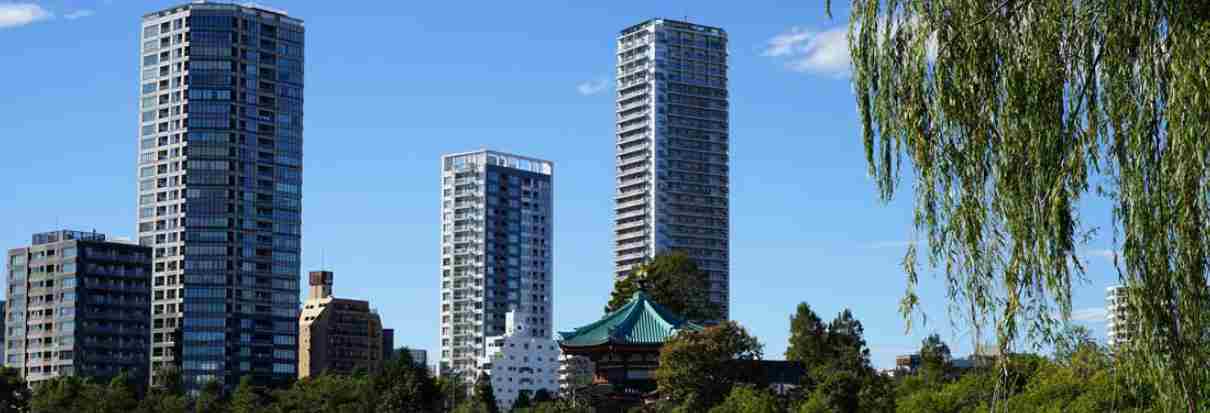
▲ Shinobazu Pond has views of the Bentendō and apartments beyond.
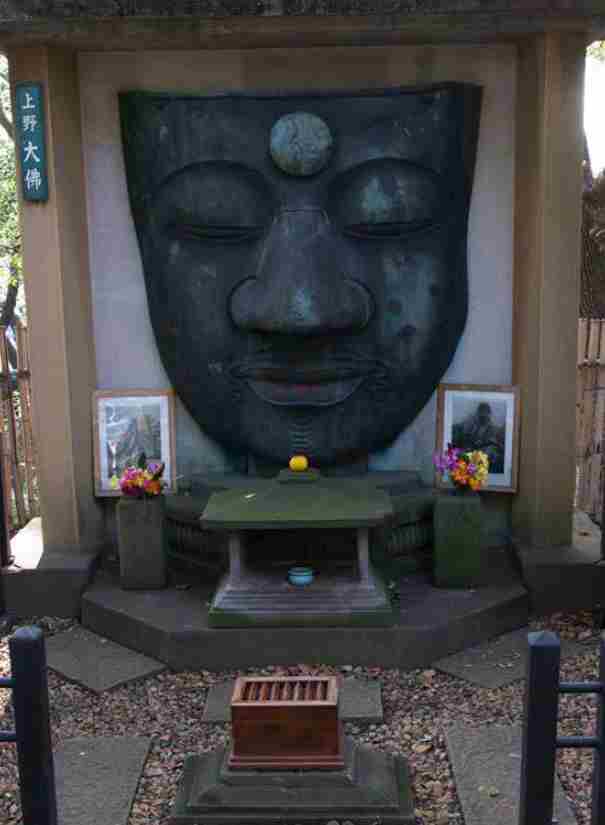
▲ This is what remains of Ueno Daibutsu, the rest was used for weapons in World War II.
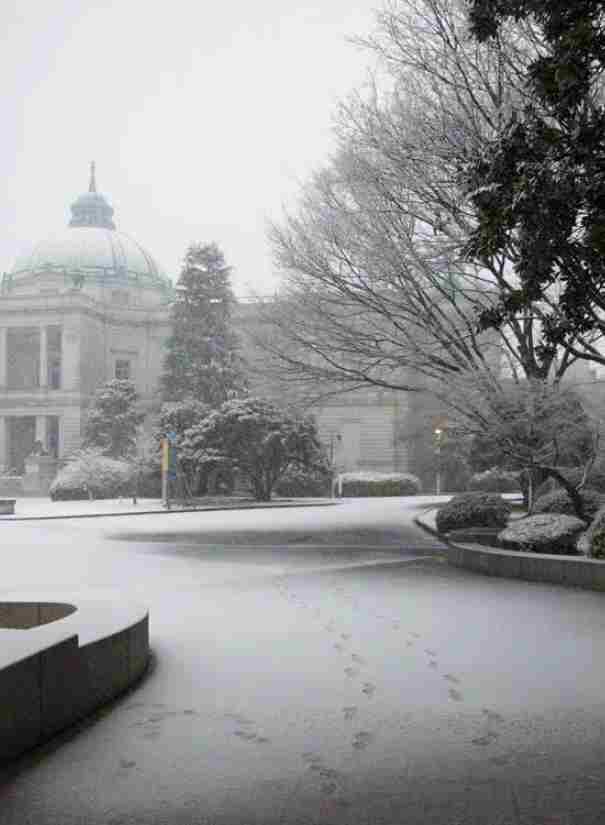
▲ The Hyōkeikan at the National Museum seen during a January snowfall.
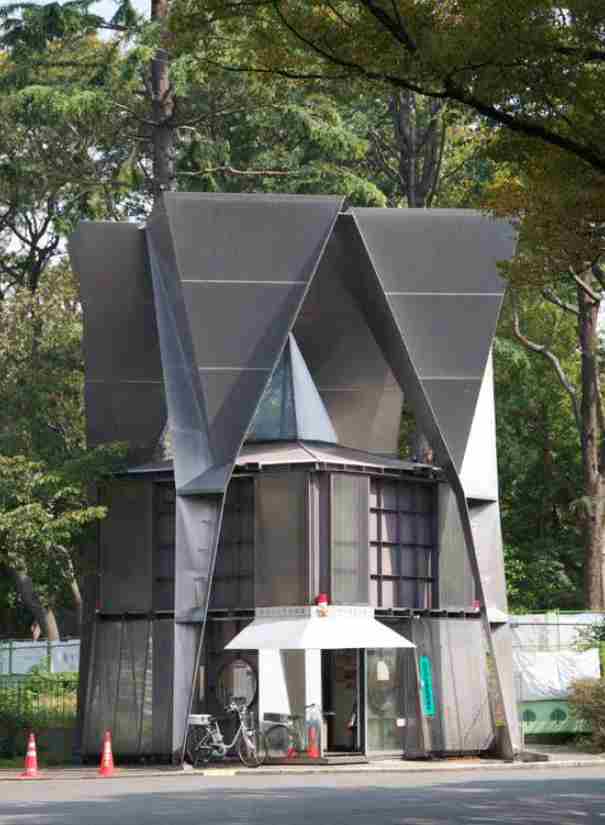
▲ A kōban designed by Kurokawa Tetsuro: ask for directions here if you are lost.
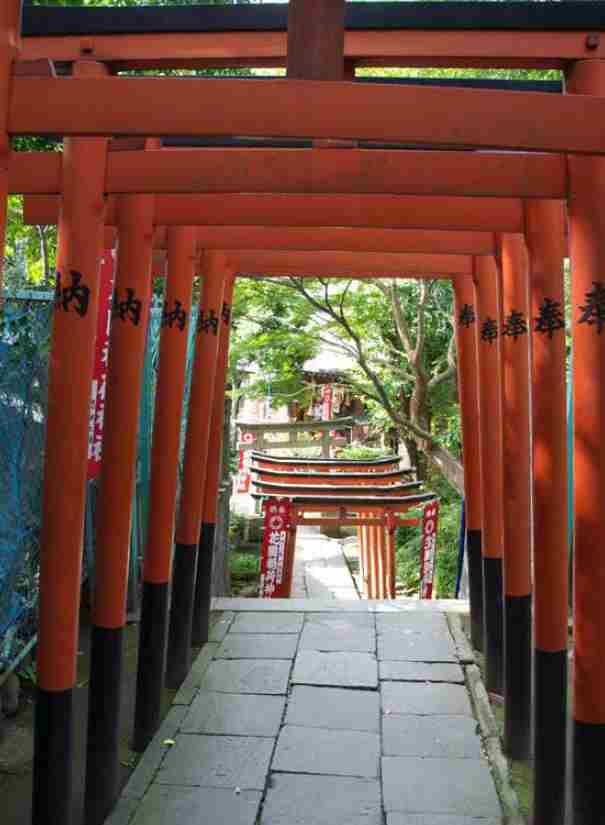
▲ Easy to spot from the sakura-lined main road, these torii lead to Hanazono Inari Jinja.
The original Seiyōken was a hotel catering to non-Japanese that was established in the foreign settlement at Tsukiji in 1872. When the Ueno Seiyōken restaurant opened in 1876, it was one of the first restaurants serving Western cuisine in Japan. It is known for several dishes that combine Western and Japanese elements, including its hayashi rice and beef stew with lotus root. The multistory building itself is of recent construction and not terribly impressive on the outside. The dining areas are spacious, and there are terraces with great views over the park and Shinobazu Pond. There are also special halls for banquets, wedding receptions, and Buddhist memorial services. There are other branches, including one near Ueno Station.
 http://www.norenkai.net/en/portfolio-item/ueno-seiyoken/
http://www.norenkai.net/en/portfolio-item/ueno-seiyoken/
DETAIL 4
 Shinobazu Pond / Shinobazu no Ike 不忍池
Shinobazu Pond / Shinobazu no Ike 不忍池
A large natural pond famous for the lotus plants that fill part of it and the Bentendō in the middle. During World War II the pond was drained and turned into fields to grow crops. The pond is divided into three parts by walkways. There are lotus plants in the south, boating in the west, and a cormorant rookery, considered a part of Ueno Zoo, in the north. Recently a deck extending into the lotus field was added. This is a good place to take photos of the surrounding area. The lotus are usually in bloom from mid-July to mid-August. The pond is also popular with birders, who set up tripods with cameras outfitted with telephoto lenses.
From mid-July or early August, the Ueno Summer Festival is held at the area on the south edge of the pond.
 Shinobazu no Ike Bentendō 不忍池弁天堂
Shinobazu no Ike Bentendō 不忍池弁天堂
This temple to Benten was built in the early 17th century on the island in Shinobazu Pond. It was designed by the priest Tenkai to be symbolic of the Benzaiten shrine of Chikubushima island on Lake Biwa. Originally one needed to be ferried out to the island; it is now accessible via causeways. The original temple was destroyed in World War II and rebuilt in 1958 preserving the original style. The Bentendō was a common subject for ukiyo-e prints and today is popular with photographers. There are several memorial monuments and sub-shrines. Some of the memorial stones are dedicated to animals killed for restaurants: chickens (the torizuka), turtles, fugu, and fish and shellfish in general. Throughout the island you will see the lotus as a motif on lanterns and other objects.
UENO DETAIL 4
Behind the Shinobazu no Ike Bentendō is Shōten Isle, connected to the island that houses the Bentendō with a bridge. The Shōten Isle has a small Shōten shrine, some sacred carvings, and a phallic stone. One side of this phallus has a figure carved into it; however, it is usually visible only from a distance when standing inside the zoo. While the stone is old, the carving dates from the Meiji period. It was likely an attempt to prevent the phallus from being destroyed in one of the government’s crusades of morality when religious depictions of sexual imagery were banned. The carving is commonly referred to as Hige Jizō (Bearded Jizō), but in 1922 Shizume Tōsen identified it as a carving of En no Gyōja and it is similar to other carvings of him. The island is fenced off and the gate is usually locked unless there is a special holiday. Once around the New Year, I was able to get on the island along with a group of women who had come to pray at the shrine.
DETAIL 5
A tiny shrine inside the Tōshōgū shrine complex. This tanuki guards the area, and prayers are offered for good luck and passing exams. You can purchase ema that depict chrysanthemums and tanuki wearing purple priest robes.
Founded in 1627, this shrine was moved and rebuilt at the present site in 1651. Significant restoration work to these original buildings was finished in 2013. It was originally founded to honor the first Tokugawa shōgun Tokugawa Ieyasu and enshrine him as Tōshō Daigongen. Presently three Tokugawa shōguns are enshrined here: Ieyasu, Iemitsu (the third shōgun), and Yoshinobu (the last shōgun). The shrine is in an ornate one, dense with paintings from the Kano school, carvings, lacquer, and gilding. The grounds contain nearly 200 lanterns donated by various daimyō around Japan, fifty of which are copper. The beautiful Karamon with its famous carvings of two dragons has a legend attached to it that the dragons would leave at night to go drink in Shinobazu Pond. To the left of the entrance is the Obakedōrō, a stone lantern so large that it gained this nickname that means “monster lantern.” The shrine is also famous for its peony garden, which is popular with flower lovers. As you look around the grounds of the shrine you will also see peony patterns repeated here and there. This shrine is popular for prayers for family and safety on the road.
Festivals include: Ueno Tōshōgū Taisai, April 17; and Botan Matsuri (Peony Festival), mid-April through mid-May. The garden also has some forty varieties of winter blooming peony.
 https://www.uenotoshogu.com/en/
https://www.uenotoshogu.com/en/
A five-story pagoda built in 1639 as part of the temple complex at Kan’eiji. Given to the city of Tokyo in 1958, it is actually in the grounds of the Ueno Zoo. You can also get a good view of it from Tōshōgū Shrine. The design is unusual as each tier is in a Japanese style; the usual pattern is to have the top tier in a Chinese style.
 Ueno Zoo / Ueno Dōbutsuen 上野動物園
Ueno Zoo / Ueno Dōbutsuen 上野動物園
Ueno Zoo was founded 1882 as Japan’s first Western-style zoo. Over time it has grown to cover some thirty-five acres including part of Shinobazu Pond. The zoo is divided into two parts, as a road runs through it. One can take a pedestrian bridge to get between the two sections. Since 1972 the superstars of the zoo, placed near the entrance, have been the giant pandas. The zoo has a wonderful exhibit of nocturnal animals. Once I was standing there when a group of preschoolers in their yellow caps came through, and as they passed the aye-ayes they suddenly began to sing a song about them.
 https://www.tokyo-zoo.net/english/ueno/index.html
https://www.tokyo-zoo.net/english/ueno/index.html
UENO DETAIL 5
 Ueno Keisatsusho Dōbutsuen mae Kōban 上野警察署 動物園前交番
Ueno Keisatsusho Dōbutsuen mae Kōban 上野警察署 動物園前交番
One landmark of Ueno Park is the kōban, not far from the Ueno Zoo entrance, that was designed by Kurokawa Tetsuro and built in 1990. The four inverted and elongated pyramid units above it make this two-story metal structure unusual among kōban. Need directions? Just ask here.
 National Museum of Western Art / Kokuritsu Seiyō Bijutsukan 国立西洋美術館
National Museum of Western Art / Kokuritsu Seiyō Bijutsukan 国立西洋美術館
If you are like me, your first thought may have been, “Why would I want to look at Western art on a trip to Japan?” Well, there are certain things one can only see here. The core collection of the museum belonged to Matsukata Kojirō, who bought the works in France. After World War II the French government declared them French property and confiscated them; in 1959 France gave them to Japan. The building that houses the collection was appropriately designed by Le Corbusier, with a new wing in 1979 by Maekawa Kunio. From that core group of some 400 items, the collection has been added to over time. Some of the works are actually outside the museum, such as Rodin’s The Thinker and The Gates of Hell. Labeling is in Japanese and English. The museum often has excellent temporary exhibits loaned from other institutions.
 National Museum of Nature and Science / Kokuritsu Kagaku Hakubutsukan 国立科学博物館
National Museum of Nature and Science / Kokuritsu Kagaku Hakubutsukan 国立科学博物館
Originally opened in 1877, the building was damaged in the Great Kantō Earthquake and rebuilt in 1931. Further renovations occurred in 2007. This museum is a major research institution participating in research not only in Japan but all over the world. The original building has six floors, three of which are underground. There are areas on all six floors devoted to different parts of the world, and on three floors exhibits specifically on Japan. Be sure to visit the large modern exhibit space behind the older building—it is all too easy to miss that second structure. The museum shop sells a guidebook to the collections. I highly recommend that you stop here if you have any interest in natural sciences or archaeology, or if you just need to get out of the rain.
 http://www.kahaku.go.jp/english/
http://www.kahaku.go.jp/english/
NOTE: If you are over 65, show your ID at the ticket counter for free admission.
 Tokyo Metropolitan Art Museum / Tōkyō To Bijutsukan 東京都美術館
Tokyo Metropolitan Art Museum / Tōkyō To Bijutsukan 東京都美術館
Originally founded in 1926 as the Tokyo Prefectural Art Museum, in 1943 the museum was given the present name. The current building dates from 1975 and is designed by Okada Shinichiro. The new building was constructed adjacent to the old building so the museum could still operate during construction. In 2012 the museum reopened after two further years of work on the building. The old site is now a garden. There are four floors with galleries on each, two restaurants plus a cafe, a breastfeeding room, a lounge to relax in, and a library. Exhibits are international in scope and occasionally highlight young upcoming artists.
DETAIL 6
 Sōgakudō Concert Hall of the Former Tokyo Music School / Kyū Tōkyō Ongaku Gakkō Sōgakudō 旧東京音楽学校奏楽堂
Sōgakudō Concert Hall of the Former Tokyo Music School / Kyū Tōkyō Ongaku Gakkō Sōgakudō 旧東京音楽学校奏楽堂
The oldest concert hall in Japan, in use since 1890. In the early 1970s it was going to be torn down and replaced with a modern building. A movement of locals and Tokyo University of the Arts alumni were able to stop the demolition. It is now maintained by the Taitō Ward government, which had it moved to Ueno Park. There is another modern hall with the same name on the grounds of the Tokyo University of the Arts.
 http://www.taitocity.net/zaidan/sougakudou/
http://www.taitocity.net/zaidan/sougakudou/
UENO DETAIL 6
 Tokyo National Museum / Tokyo Kokuritsu Hakubutsukan 東京国立博物館
Tokyo National Museum / Tokyo Kokuritsu Hakubutsukan 東京国立博物館
This museum consists of several buildings and includes the largest collection of Japanese art in the world, as well as art from other Asian countries. It also has an extensive collection of Japanese archaeological artifacts. Josiah Condor designed the original main hall, the Honkan (本館), which opened in 1881. The Honkan was damaged in the Great Kantō Earthquake and replaced by the present structure designed by Watanabe Jin, which opened in 1938. The central Honkan houses Japanese art from the Jōmon period to recent times and the museum store. It consists of twenty-four rooms in two stories. To the right of the entrance is the Tōyōkan (東洋館), which has five floors of Asian art. Opened in 1968, its long frontage gives the impression of it being a shorter building than it is. To the left of the entrance to the grounds is the Hyōkeikan (表慶館), which opened in 1908 to commemorate the wedding of the crown prince in 1900. Beyond it, the Hōryūji Hōmotsukan (法隆寺宝物館) houses treasures from Nara’s famous temple given to the imperial household in 1878. This 1999 structure designed by Yoshio Taniguchi is one of the most modern and minimalist buildings in Ueno Park, with a simple pond and a square canopy in front of the entrance. Next to it is the Shiryōkan (資料館), the Research and Information Center, which is mainly for scholars researching the document collection. Further on and to left of the Honkan, connected to it by a passageway, is the Heiseikan (平成館), which contains the archaeological gallery plus four special exhibit galleries. It was constructed to commemorate the wedding of the crown prince in 1993. Behind the Honkan are several buildings that are part of the museum and the garden.
This temple was founded in the 17th century. The main building dates from 1722. The main statue of the Buddha is hidden behind a statue of Daikoku, who is also enshrined here, so Gokokuin is on the Shichifukujin tour for the area. The third day of each month is a special day for prayers with a Tendai goma fire ritual performed around 2:00 p.m.
 The University Art Museum, Tokyo University of the Arts / Tokyo Geijutsu Daigaku, Daigaku Bijutsukan 東京藝術大学 大学美術館
The University Art Museum, Tokyo University of the Arts / Tokyo Geijutsu Daigaku, Daigaku Bijutsukan 東京藝術大学 大学美術館
Ueno Park is not the only place in this area with art museums. The Tokyo University of the Arts has its own collection housed in a new facility that opened in 1999. Included in the collection are student works dating back to the founding of the school. Besides the main building, there are the Chinretsukan Gallery, Masaki Memorial Gallery, and the Toride Annex.
 https://www.geidai.ac.jp/museum/
https://www.geidai.ac.jp/museum/
 International Library of Children’s Literature / Kokusai Kodomo Toshokan 国際子ども図書館
International Library of Children’s Literature / Kokusai Kodomo Toshokan 国際子ども図書館
Built in 1906 as the Imperial Library, in 1949 it became the Ueno Library. Starting in 1998 the present building was reworked by Andō Tadao. The most visible changes seen from the outside are the modern entrance hall encased in glass, a cafeteria of similar design directly opposite the building, and a third-floor extension above the garden that is also encased in glass. In 2000 it reopened under its present name as a branch of the National Diet Library, with a collection of over 500,000 books. As is most appropriate for such a library, there are diaper changing rooms and a nursing room. Adults are welcome in the Children’s Library. The fountain at the library has a bas-relief of Koizumi Yakumo, who is better known in the West as Lafcadio Hearn.
 http://www.kodomo.go.jp/english/
http://www.kodomo.go.jp/english/
DETAIL 7
A Tendai Buddhist temple established in 1625 by the order of the shōgun Tokugawa Hidetada. This temple is also officially known as Tōeizan Kaneiji. Kaneiji became one of the official family temples of the Tokugawa shōguns. The original temple was part of one of the largest religious complexes in Edo. The complex was mostly destroyed in the Battle of Ueno. The present Kaneiji, much smaller than the original and once a sub-temple in the original complex, is located in the area north of the National Museum. It houses the original temple’s image of Yakushi Buddha. Six of the Tokugawa shōguns are buried here in a private cemetery viewable from the street. In the Edo period the city had nine bells that would toll at six in the morning and six in the evening; one of them was the bell at Kaneiji.
The entrance is to the southwest., but you can also enter from the southeast or northwest.
UENO DETAIL 7
This Tendai Buddhist temple was founded in 1666. Sometimes the name is romanized as Jyōmyōin. The grounds contain thousands of stone Jizō statues, part of a project started in 1850. More are added regularly. The temple has set a goal of 84,000 statues, as this is a symbolic number in Buddhism. A tradition speaks of 84,000 different teachings by the Buddha for various people based on their needs. There is a beautifully crafted large bronze Jizō dating from 1906 that is a memorial to the dead from the Russo-Japanese War. Early in Tran Anh Hung’s film Norwegian Wood there is a scene that was filmed among the stone Jizō here.
Each August there is a hechima memorial service where prayers are offered for relief from coughs and asthma. The sap from hechima, known as loofa in the West, is an old treatment for coughs.
The entrance is to the south.
Kaneji Memorial
One interesting item on the grounds of this temple is the mushizuka, a memorial mound for insects killed in the production of the Chūchijō, a famous book of realistic insect illustrations that is in the National Museum. The mound has a large boulder surrounded by plants with the kanji 冢蟲 carved on it above an inscription.
